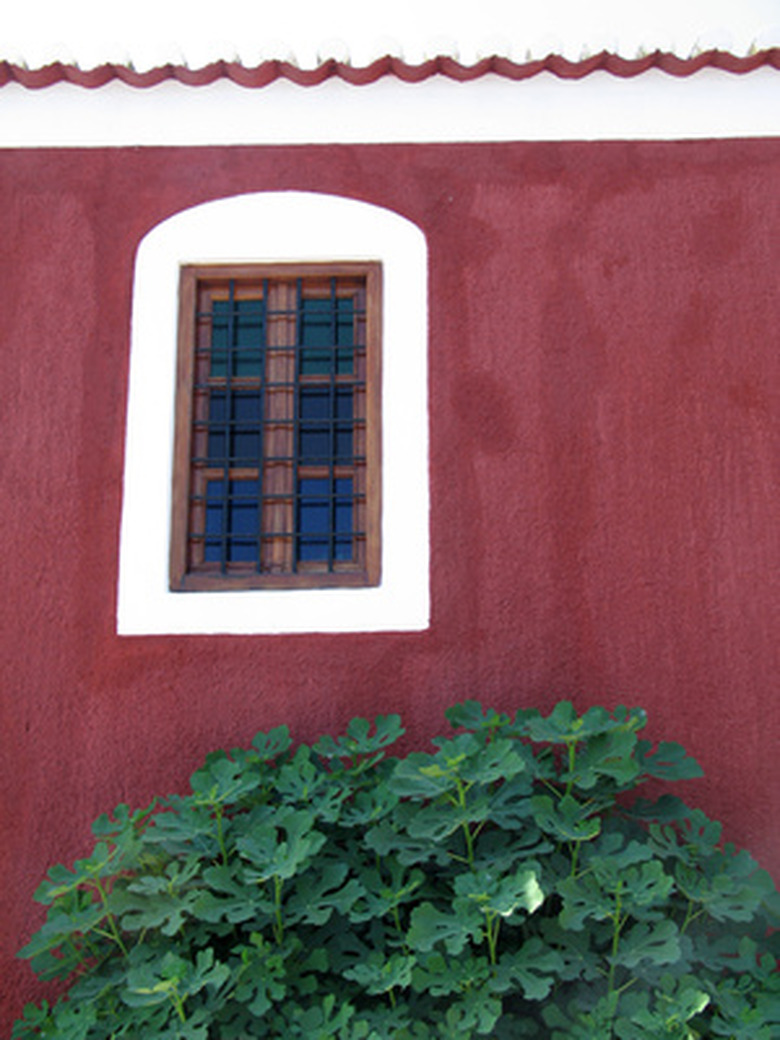The Best Plants & Trees Against A Hot Stucco Wall
A planting bed next to a hot stucco wall can present problems for most gardeners. Reflected heat, especially intense if the wall has a south or west facing exposure, can rapidly desiccate foliage. There are a few plants that will not only tolerate these conditions, but thrive on them. Most are native to hot and dry climates and are well adapted to gardens that replicate their original habitat.
Ceanothus thyrsiflorus
Ceanothus thyrsiflorus (California Lilac) is a large evergreen shrub that produces masses of blue flowers. Despite its bushy form, it can be easily trained to grow along a wall in an informal espalier. An espalier is a plant trained to grow on a flat, vertical surface. This training style is decorative and makes good use of space, beautifying an otherwise blank wall. Varieties such as "Concha" and "Skylark" lend themselves readily to growing in a small area, or can be trained on a framework. Drought tolerant once established, this plant will thrive in high heat. Cold hardiness can vary and, although it is rated for zones 7 through 10, a very wet winter or a prolonged hard freeze can cause foliage die back. Providing well drained soil and the warmest area of the yard will maximize winter hardiness in marginal areas.
- A planting bed next to a hot stucco wall can present problems for most gardeners.
- Despite its bushy form, it can be easily trained to grow along a wall in an informal espalier.
Ficus carica
Ficus carica (common fig) is an underutilized shrub or small tree for warm areas. Figs have long, easily trained branches and respond well to pruning. This is another good selection for an informal espalier. Fruit production is an added bonus, with many varieties ripening a spring and a fall crop. Figs love heat and full sun, but they do need regular summer water for proper fruiting. Inadequate or erratic watering can cause fruit drop or cracking. Soil should be well drained and slightly on the alkaline side. Acid soils can be remedied by a yearly surface application of agricultural lime. Most figs are hardy in zones 7 through 10.
- Ficus carica (common fig) is an underutilized shrub or small tree for warm areas.
- Figs love heat and full sun, but they do need regular summer water for proper fruiting.
Fremontodendron californicum
Fremontodendron californicum (California flannel bush) has an open, shrub-like form that can be pruned and trained to grow against a wall or on a lattice. The biggest draw with this plant is the abundance of large, bright yellow flowers it produces. Fremontodendron is evergreen in most areas, but in colder climates it may be deciduous. Well drained soil is an absolute must for this southwestern native. It easily grows in high temperatures, but too much water or poorly drained soil will quickly kill it. Care should be exercised when pruning, as the leaves have tiny hairs that can cause skin irritation in some individuals. It is hardy in zones 8 through 10.
- Fremontodendron californicum (California flannel bush) has an open, shrub-like form that can be pruned and trained to grow against a wall or on a lattice.
Punica granatum
Punica granatum (pomegranate) is both ornamental and provides a fruit crop in warm climates. Ripe fruit is far more likely if this plant is given the hottest place in the yard. Easily pruned and trained, the pomegranate has a loose, almost pendulous form, making it a good selection for growing against a wall. Flowers are bright red and tubular in form. Hummingbirds are very attracted to this shrub when it is in bloom. Fruits require high heat and a long season to ripen, although varieties such as "Sweet" and "Eversweet" will mature even in cool summer areas. Pomegranates need well drained soil and some supplementary water in summer. They are tolerant of a wide variety of soils with the exception of heavy clay and are hardy in zones 8 through 10. "Eversweet" is hardy in zone 7.
- Punica granatum (pomegranate) is both ornamental and provides a fruit crop in warm climates.
- Easily pruned and trained, the pomegranate has a loose, almost pendulous form, making it a good selection for growing against a wall.
References
- "Flora: A Gardener's Encyclopedia"; Sean Hogan; 2003
